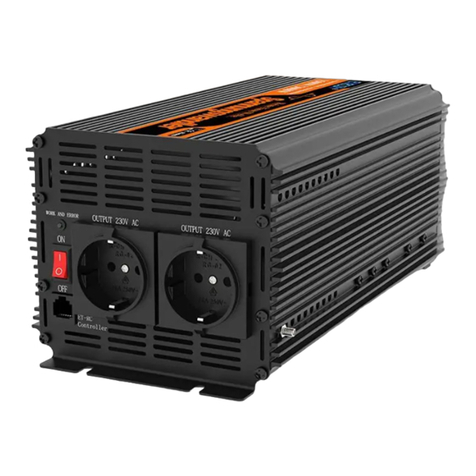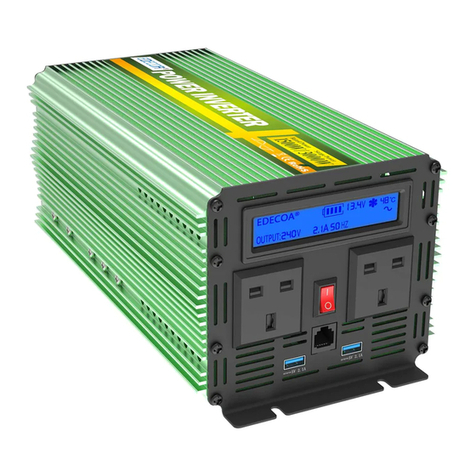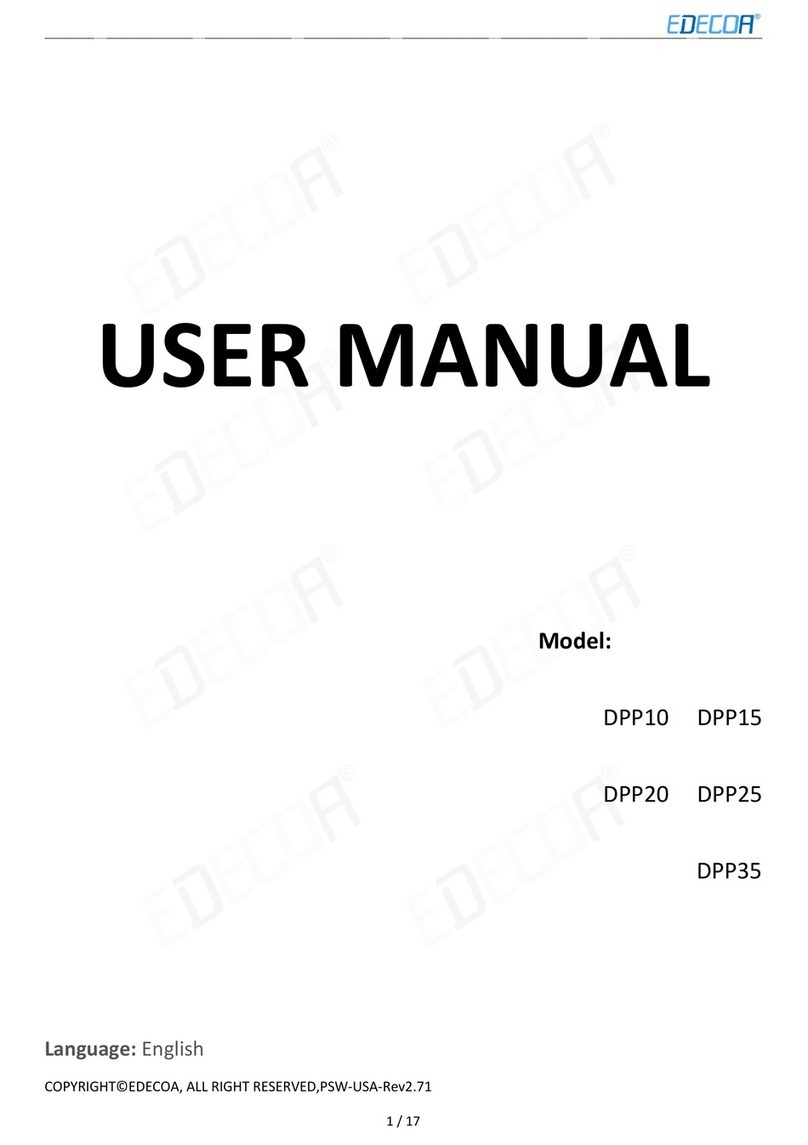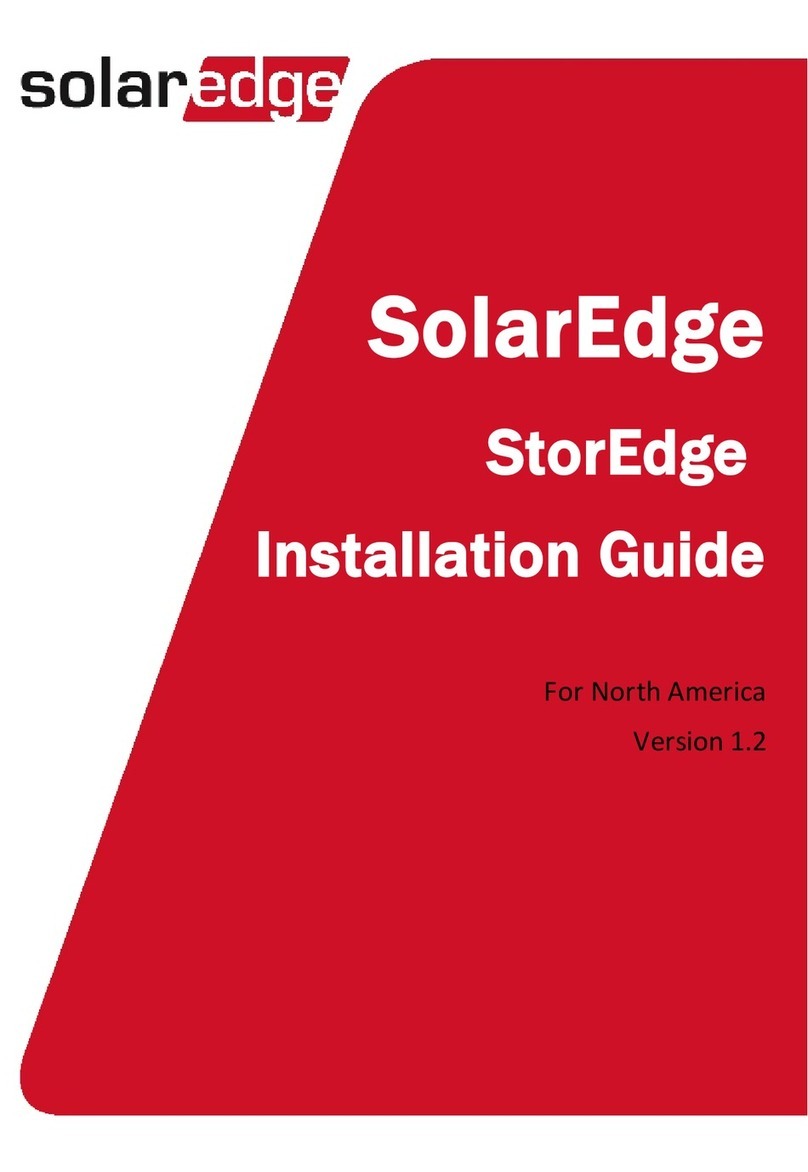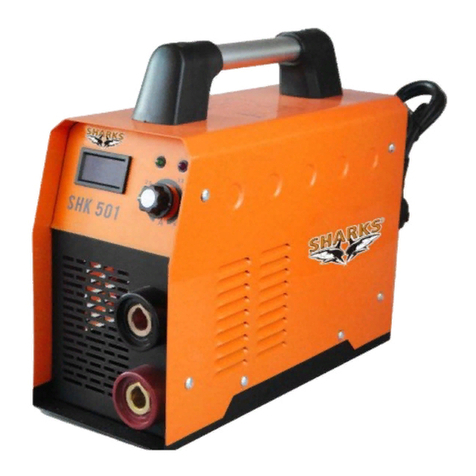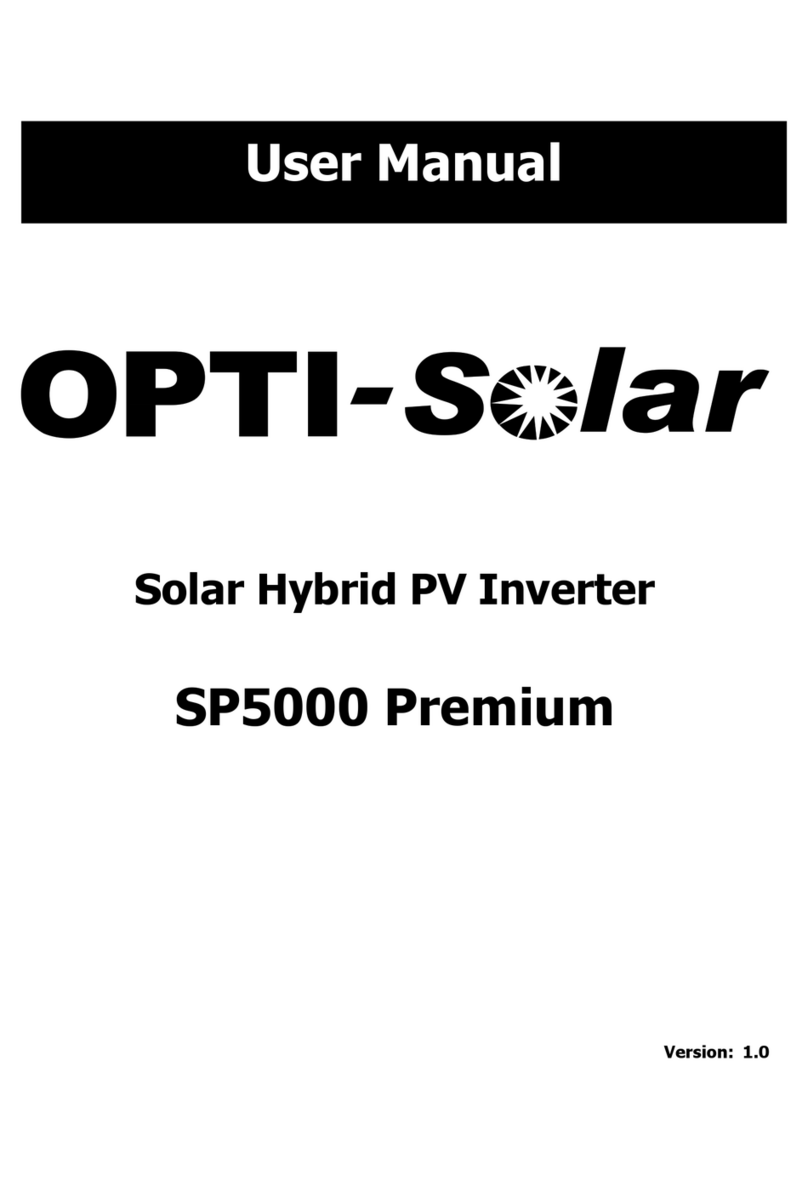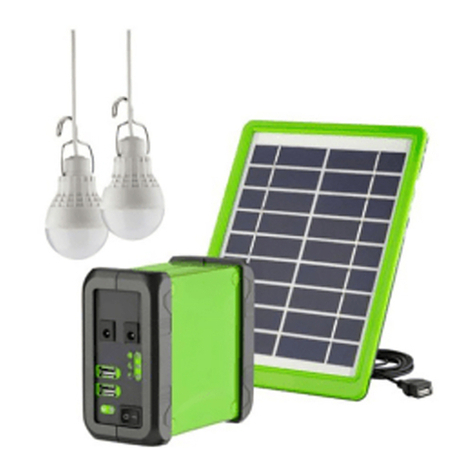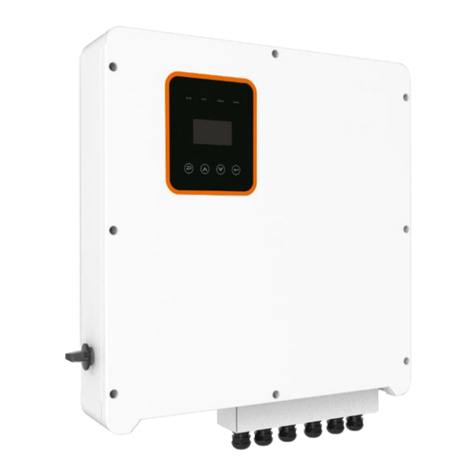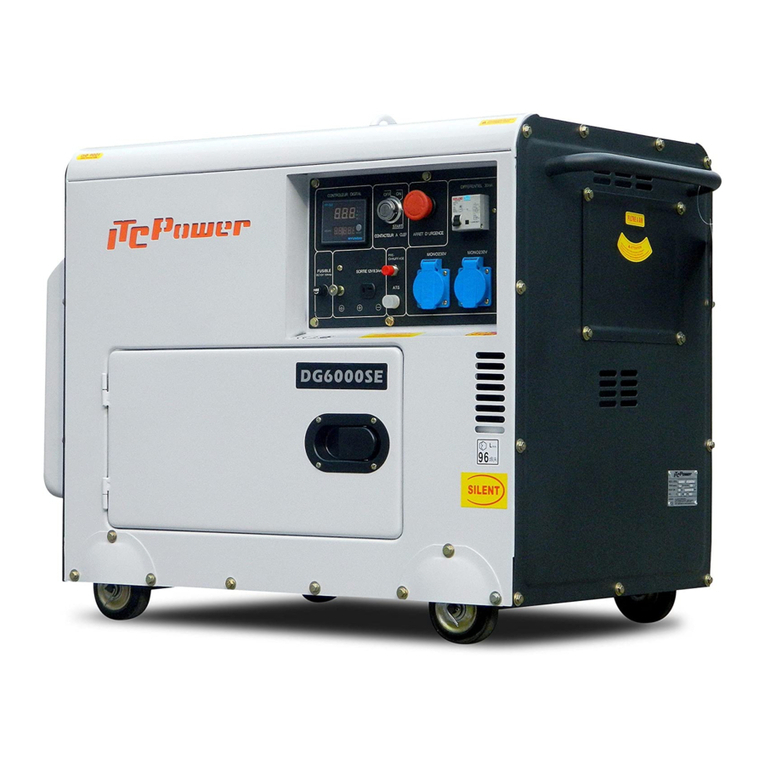EDECOA DPM10 User manual

COPYRIGHT©EDECOA, ALL RIGHT RESERVED, PI-USA-Rev 2.6
1 / 17
USER MANUAL
Model:
DPM10 DPM12
DPM15 DPM20
DPM25 DPM30
DPM35
Language: English

COPYRIGHT©EDECOA, ALL RIGHT RESERVED, PI-USA-Rev 2.6
2 / 17
1. What is the power inverter?.................................................................................................................................... 3
2. Inverter appearance description............................................................................................................................ 13
3. Intended use............................................................................................................................................................ 4
4. Installation...............................................................................................................................................................4
5. Opening the device..................................................................................................................................................5
6. Connection.............................................................................................................................................................. 5
7. About the remote controller.................................................................................................................................... 6
8. Service environment................................................................................................................................................8
9. Notice about modified sine wave inverter.............................................................................................................. 8
10. Technical data....................................................................................................................................................... 9
11. How to select the proper inverter you need?........................................................................................................9
12. How to choose the proper cable?........................................................................................................................ 10
13. Batteries using time.............................................................................................................................................11
14. How to connect two or more batteries?...............................................................................................................12
15. Protection features...............................................................................................................................................12
16. Problem Causes...................................................................................................................................................12
17. HoW many watts do you need?.......................................................................................................................... 13
18. Do i need modifed wave or pure sine wave inverter?.........................................................................................15
19. What is an over current protection device and why do you need one.................................................................15
20. Special use...........................................................................................................................................................15
21. Improper use of power inverter...........................................................................................................................16
21. Disposal...............................................................................................................................................................17
22. Warranty..............................................................................................................................................................17
23. Compensation......................................................................................................................................................17

COPYRIGHT©EDECOA, ALL RIGHT RESERVED, PI-USA-Rev 2.6
3 / 17
1. WHAT IS THE POWER INVE RT ER?
The power inverter converts direct-current (DC) low voltage (12V model, 24Vmodel ,48V model) power to 120V
alternating-current (AC) that you can use to operate all kinds of devices, like kitchen appliances, microwave, air
conditioner, TV, computer or work tools. You just connect the battery and devices to the inverter. Then you've got
portable power. It is simple and you can use it anywhere, anytime, you will always be able to run your devices from
battery.
2. INVERTER APPEARANCE DES CRIP TION
①LCD Display
②Outlets:15A/120VAC
③Power ON/OFF Switch
④AC Output : 3P Terminals
⑤Remote Control Port
⑥Dual USB Charging
⑦GND Terminal
⑧Battery input -
⑨Battery input +
⑩Fans
⑪LED Status Display

COPYRIGHT©EDECOA, ALL RIGHT RESERVED,PSW-USA-Rev2.6
4 / 17
3. INTENDED USE
This inverter is used to convert low voltage (Direct Current-DC) into alternating voltage of 120V AC, for example, from
battery (preferably deep-cycle) or in photovoltaic-island systems.
A very simple way to use an inverter for emergency power (such as during a power outage), is to use a car battery (with
the engine running), and an extension cord running into the house, where you can then plug in electrical appliances.
Please use the inverter according to the following instruction and in accordance with the standards and guidelines
applicable locally. Any other use may cause injury or property damage. These inverters are not suitable for the supply of
life support and / or medical equipment. The inverters are no Uninterruptible Power Supply!
4. INSTALLATION
4.1 Caution: IMPORTANT NOTICE PRIOR TO USING
Do not install the inverter on flammable building materials.
Do not install the inverter in areas where flammable or explosive materials are stored.
The inverter must only be installed by sufficient trained personnel in compliance with local safety regulations.
When the inverter is running, the temperature of the chassis and the heat sink can be high. Do not install the inverter in
locations where it can be inadvertently touched.
Ambient temperature should be kept below 50 ℃, to ensure the best inverter operating conditions, and extend its
service life.
Inverter should be installed in a well-ventilated environment to ensure good heat dissipation.
Avoid placing the inverter in direct sunlight, rain and snow. This can extend the life of the inverter. It is advisable to
select the installation site with occlusion but ensure proper air-circulation.
Inverter protection class IP65, indoor and outdoor environment can be used.
The mounting method and position must be suitable for the weight and dimensions of the inverter, please refer to the
technical data.
4.2 Checking accessories
After unpacking the inverter package, check that the delivery unit is complete and that there is no visible external damage.
If any items are missing or if there is any damage, contact your dealer.
Check that the package contains the deliveries as listed below:
1) Power Inverter ×1
2) One pair of screw cap (Red and Black)
3) One pair of DC input terminal ring (For backup,Some models)
4) User manual ×1
5) Ground Cable×1
6) Battery cable
7) Remote controller and connecting cable
8) Spare fuse (Some models)
You need to choose the appropriate location to install the inverter to ensure that the inverter can work properly and
efficiently.
4.3 Install carrier requirements
The inverter mounting carrier must be fire-resistant.
Do not install the inverter on flammable building materials.
Please ensure that the mounting surface is strong enough to meet the load requirements of the inverter.
In a residential area, do not install the inverter on a plasterboard wall or similar sound-poor wall to avoid
interference with the noise in the work area.
4.4 Installation requirements:
Install it vertically or tilt it back up to 15 ° to allow the fan to cool the machine.

COPYRIGHT©EDECOA, ALL RIGHT RESERVED,PSW-USA-Rev2.6
5 / 17
Figure 3-1 Proper installation Figure 3-2 Installation Space (Unit: inch)
Do not install the inverter in an inclined position (forward, backward, overturned), horizontally mounted or inverted.
4.5 Installation space requirements
It is recommended that the inverter be mounted at an adequate height for easy operation and subsequent
maintenance.
When installing the inverter, make sure that there is enough space around the inverter to ensure adequate installation
and cooling space, as shown in Figure 3-2.
5. OPENING THE DEVI CE
Non-professional personnel must not open the inverter as there is high voltage inside. Before opening the device,
please remove cables of both DC and AC sides, turn on the switch and leave the inverter alone for 1 hour.
6. CONNECTION
Please read the manual carefully and install the inverter properly. If you have questions, please contact our service team.
It may cause damage to the inverter or cause injury if you do not act in accordance with the instructions from the manual.
6.1 Battery connection
1. Set the switch to the "OFF" position when connecting the inverter to the power source. The energy source may be a
battery or other stable DC power supply. It must be ensured that the DC voltage of the power source is matched to
the rated DC voltage of the inverter. Higher voltages can cause damage the inverter.
2.
3. The load power should not exceed the rated power of the inverter.
The two DC-input connectors of the inverter are color-coded:
The red terminal for the positive pole (+) The black terminal for the negative pole (-).
Inverter DC input installation method:

COPYRIGHT©EDECOA, ALL RIGHT RESERVED,PSW-USA-Rev2.6
6 / 17
Please fix the battery cables on the positive and negative terminals of the inverter tightly. Otherwise, there will be
large current which will result in severe heating problem and parts damaged.
6.2 Load connection
Connect your device into power inverter AC outlet. (Make sure your device’s rated power is less than the inverter’s,
and the working voltage is 120V)
The connections between power source (battery) and inverter cable terminals must be securely mounted.
Set the switch to the "ON" position
Tips:
The battery must be able to deliver necessary amperage according to the power of the inverter and load. For example,
for a 24v inverter to drive 1000W resistive load, the battery should be able to provide more than 45 amps! (On a 12V
inverter it will be >90 amps!)
Please do not connect the AC output side to other power source (i.e. electric supply) as this is not a grid interactive
inverter.
The cover should be connected to protective ground before usage. Please switch off the inverter and only on as
necessary to avoid power consumption from the batteries without load when it is not being used.
Use the supplied cable from the manufacturer or at least those with the same or larger cross-section.
Keep these connections as short as possible, it will flow considerable current depending on power extraction!
The inverter should be installed in a dry and well-ventilated area. The air inlet may not be blocked, and it should be
kept 20cm away from the wall.
Do not install the inverter near flammable or explosive material. Please use dry cloth to clean the inverter. Do not
stack multiple inverters in operation above another so as the cooling is not guaranteed.
6.3 Grounding wire installation
The connection method of the ground wire is different based on the different using environment (vehicle,
boat, home, outdoors) . You could find where to connect the ground cable in the power inverter following that icon “ ”
When using the power inverter in a vehicle, please connect the ground wire to the chassis of the vehicle.
When using the power inverter on a boat, please connect it to the boat's ground system.
When using the power inverter at home, please connect it to the home ground wire system. If there is no ground wire
system at home, please connect it to the negative terminal of the battery.
When using the power inverter outdoors, please connect it to the negative terminal of the battery. It will not affect
the normal working of the power inverter without connecting the ground wire.
7. ABOUT THE REMOTE CONTROLLER
Tips: The switch of the remote control and the switch of the inverter is parallel.
Therefore, when any one controls the inverter, the other switch must keep the "OFF" state.
According to different models, we have two models of remote control (ED-RC, ET-RC). However, it is not possible to
replace each other.

COPYRIGHT©EDECOA, ALL RIGHT RESERVED,PSW-USA-Rev2.6
7 / 17
ED-RC remote controller
1. ON/OFF switch
2. Status light: If it is green, it means the inverter is on. If it is off, then the inverter is off.
3. Low input voltage indicator light: If the DC input voltage of the inverter is too low, it will be yellow
4. Battery power indicator light:
If DC voltage ≥12.5V, 4 LED lights will be green
If 12V≤DC voltage≤12.5V, 3 LED lamps will be green
If 10.8V≤DC voltage≤12V, 2 LED lamps will be green
If 10V≤DC voltage≤10.8V only 1 LED lamp will be green
Note: If your inverter is 24v, please multiply the above DC input voltage by 2.
About ED-RC remote cable
ED-RC remote cable is 6.5ft or 13ft long standard RJ45 network cable, it is easy for you to extend the length of it. When
working, the voltage drop through this 6.5ft cable is about 0.02V, you can ignore it. If it is a 33ft long cable, the voltage
drop will be about 0.1V. If you use very long remote cable, please note that the battery power indicator light maybe not
correct.
If the remote cable has problem, it may cause the following problems:
1. The inverter can’t be turned ON/OFF by the remote controller, only the battery power indicator light works.
2. After connecting the remote controller, the inverter will be always on, the inverter can’t be turned off, the battery
power indicator light can’t indicate the actual power.
3. After connecting the remote cable, the inverter will be always on, all LED lights on the remote controller are off, the
inverter can’t be turned off.
4. After connecting the remote controller, all LED lights on the remote controller are off, the inverter can’t be turn on.
5. After connecting the remote controller, the status light sometimes work, sometimes not, the inverter maybe turn off
automatically.
Note: If the remote controller can’t work properly, please try to replace the remote cable first.

COPYRIGHT©EDECOA, ALL RIGHT RESERVED,PSW-USA-Rev2.6
8 / 17
ET-RC remote controller
1. ON/OFF switch(press 3s),Backlight switch(press once)
2. LCD display
3. USB charging: 5VDC/2.1A * 2
About ET-RC remote cable
ET-RC remote cable is 13ft long standard RJ45 network cable,In order not to affect the display signal transmission, it is
recommended to use network lines within 16.5ft.
Note: If the remote controller can’t work properly, please try to replace the remote cable first.
8. SE RV ICE ENVIRONMEN T
Ambient temperature: -20~+50℃
Storage temperature: -40~+85℃
Relative humidity: 0~85% Non-condensing
9. NOTICE ABOUT MODIFIED SINE WA VE INVERTER
The output waveform of modified sine wave inverter is not pure sine wave, it is different from the waveform of our home
grid system. If you use it to run inductive loads, it is possible that the inverter can’t work properly, or its performance is
less than expected, this may also bring more noise.
1. If using a modified sine wave inverter, devices like induction cooker, coffee machine with pump or compressor inside,
medical equipment can’t work properly.
2. Motor, pump, electric saw, and devices with compressor, when starting, they may require 3-7 times power as their
rated power. It is not recommended to use a modified sine wave inverter to run these devices. If a modified sine wave
inverter is used, maybe these devices can’t start, this will also shorten the inverter’s life.
3. Fluorescent lamp (with Ballast), NiMH battery charger, it is not recommended to use a modified sine wave inverter for
long time, this devices will bring more noise with modified sine wave inverter. If using for long time, this will also
shorten the inverter’s life.

COPYRIGHT©EDECOA, ALL RIGHT RESERVED,PSW-USA-Rev2.6
9 / 17
10. TECHNICAL DATA
11. HOW TO SELECT THE PRO PER IN VE RTER YOU NEED?
Dependent of the devices you want to operate, you must pay attention in the wattage of each device and calculate the
total watts. We recommend you to buy an inverter higher than the power you think you need – good practice is around
30% - 50% more.
For example:

COPYRIGHT©EDECOA, ALL RIGHT RESERVED,PSW-USA-Rev2.6
10 / 17
We recommend you to buy the power inverter 1500w. We should give some thought to a larger one, as there will likely be
a time when you wish you'd bought a bigger model... in this example, you might decide you'd like to run a fan while you
compute, or let the kids watch TV.
Sometimes devices like a motor, it need more power at startup (peak power) although after the motor is running use
continuous power. This is important to consider. For example, an air conditioner, refrigerator may need startup-power
from 3 to 7 times of the continuous power. The best procedure is to find out about the current requirement of the device
to be connected to the inverter. Normally this information is in the device specifications.
What is meant by the terms "continuous-2000 watts" and "peak surge-4000 watts" is that some appliances or tools, such
as ones with a motor, require an initial surge of power to start up ("starting load" or "peak load"). Once started, the tool
or appliance requires less power to continue to operate ("continuous load")
Example:
If you have a refrigerator with a continuous load of 3 amps and a startup load of 8 amps:
3 amps x 120 volts = 360 watts continuous
8 amps x 120 volts = 960 watts continuous
In this case you should use an inverter with 1500W.
12. HOW TO CHOOSE THE PRO PER CABL E?
Inverters should be attached directly to the battery. The wire size depends on the distance between the battery and
inverter.
The following is a reference to the cable size of the battery recommended by the DC12V system inverter. (DC24V system
inverter Cable Section Area /2)
300W continuous load
1 – 3ft Cable 11AWG
3.5 – 5ft Cable 8AWG
5.5 – 13ft Cable 7AWG
600W continuous load
1 – 3ft Cable 9AWG
3.5 – 5ft Cable 6AWG
5.5 – 13ft Cable 5AWG
1000W continuous load
1 – 3ft Cable 6AWG
3.5 – 5ft Cable 5AWG
5.5 – 13ft Cable 3AWG
1200W continuous load
1 – 3ft Cable 5AWG
3.5 – 5ft Cable 4AWG
5.5 – 13ft Cable 3AWG
1500W continuous load
1 – 3ft Cable 5AWG
3.5 – 5ft Cable 4AWG
5.5 – 13ft Cable 2AWG
2000W continuous load
1 – 3ft Cable 5AWG
3.5 – 5ft Cable 2AWG
5.5 – 13ft Cable 1/0AWG
3000W continuous load
1 – 3ft Cable 3AWG
3.5 – 5ft Cable 0AWG
5.5 – 13ft Cable 2/0AWG
3500W continuous load
1 – 3ft Cable 2AWG
3.5 – 5ft Cable 0AWG
5.5 – 13ft Cable 2*1AWG
5000W continuous load
1 – 3ft Cable 2/0AWG
3.5 – 5ft Cable 2*1AWG
>5ft Not recommended

COPYRIGHT©EDECOA, ALL RIGHT RESERVED,PSW-USA-Rev2.6
11 / 17
13. BATTERIES USING TIME
You can calculate that the storage battery’s use-time by this formula:
푈푠푖푛푔푇푖푚푒 퐻표푢푟푠 = 퐵푎푡푡푒푟푦 퐶푎푝푎푏푖푙푖푡푦 퐴퐻
푙표푎푑 푝표푤푒푟(푊) 0.85/퐵푎푡푡푒푟푦 voltage(V)
Attention:
If batteries of the same size are connected in parallel, the time is multiplied by the number of parallel batteries. For
example, four 12V 60AH batteries are connected in parallel, and 500W of load can be used continuously for 1 h 12
min*4=4 h 48 min
The above is the time that can be used when the new battery is fully charged. If it is an old battery, use it for more than
half a year and multiply it by 0.8. The battery has been used for more than one year. It needs to multiply the usage time by
0.5. For example, a 12V 100A battery has been used for half a year. If a 1000W load is used, it can be used continuously for
1h*0.8=48 min.
Tip: Use the inverter in your car. Engine start batteries should not be discharged below 90% charged state, and marine
deep cycle batteries should not be discharged below 50% charged state. Doing so will shorten the life of the battery based
on most battery manufacturers recommendations.
Note: If you intend to use power tools for commercial use, or any load of 200W for more than 1 hour regularly (between
battery recharging) we recommend installing an auxiliary battery to provide power to the inverter. This battery should be

COPYRIGHT©EDECOA, ALL RIGHT RESERVED,PSW-USA-Rev2.6
12 / 17
a deep auxiliary battery should be connected to the alternator through an isolation module to prevent the inverter from
discharging the engine start battery when the engine is off.
14. HOW TO CONNECT TWO OR MORE BATTERIES ?
Parallel connected = same voltage doubled AH (Two 12V batteries connect in paralleled will provide 12V output but
double the using time)
Connected in series = double voltage same AH (Two 12V batteries connect in series will provide 24V output)
15. PROTECTION FEATURES
Low Voltage Protection: when the battery is in discharged condition, the inverter will shut down, at the same
time, an alarm will sound and the indicator light will turn on.
Over-voltage protection: when the input voltage exceeds rated voltage, the inverter will shut down, at the same
time, an alarm will sound and the indicator light will turn on. A substantial excess of the rated voltage, for example, at
48V on a 24V inverter will destroy the inverter!
Reverse polarity protection: when the inverter is connected reversely, inverter’s fuse will blow out to protect the
inverter. The DC input side with MOSFET protection will not work.
You have to replace all burnt fuses.
Over-load protection: when the continuous draw exceeds rated Watts, the inverter will shut down, at the same
time, an alarm will sound and the indicator light will turn on.
Short circuit protection: when the output side is short circuited, the inverter will shut down, an alarm will sound
and the indicator light will turn on.
Temperature control: If the temperature in the unite reaches 45°C the fan will start and cool down the device.
Over-temperature protection: when the inside temperature is over 75°C, the inverter will shut down, an alarm
will sound and the indicator light will turn on.
16. PROBLEM CAUSES
PROBLEM POSSIBLE CAUSE SOLUTION
The inverter is ON
but the LED does
not work. No
response. No
alarm
Open circuit.
No DC input.
Fuse faulty.
1. Check entry circuit continuity
2. Check that the battery fuse is right.
3. Check all circuit connections are correct.
4. Check the ON/OFF button wiring.
The inverter is
switched on and
the LED works. No
AC output. No
alarm.
Reversed of polarity
connection on input side
and internal fuses have
been burnt.
1. Check and correct the polarity of input connections and replace
the internal fuse. (NOTE: Reversing the polarity may cause
irreversible damage to the fuse circuit)

COPYRIGHT©EDECOA, ALL RIGHT RESERVED,PSW-USA-Rev2.6
13 / 17
Unusual Low
output AC voltage
Poor battery. Internal
MOSFET faulty.
Drive circuit faulty.
1. Reverse the potentiometer on drive panel to get right output
voltage.
2. Ensure the battery is enough and full.
3. Contact the technical support.
Got 60VAC or so
while testing
inverter's ground
wire and Neutral
line ?
This voltage is an
electromagnetic induction
voltage, there is no
current leakage.
This is normal. Inverter output communication does not
distinguish hotline and neutral line, if you need to distinguish the
hotline and neutral line, please contact customer service or after-
sales technology.
The alarm sounds
1 time per time,
after 2 seconds,
same beeps again.
The input voltage is very
low. DC12V inverter: 10-
10.5V DC24V inverter: 20-
21V
1. Ensure the battery is enough and full.
2. Check that the battery cables are suitable for transporting the
DC voltage. Use a thicker or shorter cable.
3. Setting DC input circuit connections.
4. The inverter loads the electrical power exceeding the power
provided by the battery, increasing the battery specification.
The alarm sounds
2 times per time,
after 2 seconds,
same beeps again.
The input voltage is too
low and the inverter stop
working.
1. Ensure the battery is enough and full.
2. Check that the battery cables are suitable for transporting the
DC voltage. Use a thicker or shorter cable.
4. The inverter loads the electrical power exceeding the power
provided by the battery, increasing the battery specification.
The alarm sounds
3 times per time,
after 2 seconds,
same beeps again.
The input voltage is too
high. DC12 inverter:
higher than 15.5V;DC24V
inverter: higher than 30V
1. Check that the voltage at the input DC terminals does not
exceed 15V/30V.
2. Check that we are not using a panel or wind turbine not
regulated for battery charging,Make sure that the maximum
voltage of the battery controller does not supply voltages
higher than 15V/30V.
The alarm sounds
5 times per time,
after 2 seconds,
same beeps
again.
(The alarm is
beeping
repeatedly)
The load AC exceeds the
nominal power by 120%.
Short circuit in
connection.
1. The starting power of the electrical equipment is too high and
it is confirmed whether the starting power of the electrical
appliance exceeds the maximum continuous power of the
inverter.
2. Reduce load.
3. Disconnect the electrical outlet from the inverter output
outlet and restart the inverter. If you are working normally,
you need to check whether there is a short circuit in the
connected load appliance or line.
Output voltage
below 100V AC?
A True RMS voltage
meter is required to
properly measure output
voltage of modified wave
inverter
Test output voltage with a True RMS meter Try to maintain the
input voltage in the range of rated power
Change the battery of the meter then test again.
The alarm sounds
4 times per time,
after 2 seconds,
same beeps
again.
Inverter overheating 1. Check that the fan is working correctly, Try again when the
inverter has been cool down.
2. Keep the inverter in good ventilation and heat dissipation.
17. HOW MAN Y WATTS DO YOU NEED?
To select an inverter that has enough power for your application, add the watts for items you may want to run at the
same time. Use the total wattage, plus 20%, as your minimum power requirement.
Note: The wattage's given below are estimates. The actual wattage required for your appliances may differ from those
listed. Check the nameplate on the appliance to determine the actual wattage required.
* Appliances and tools with induction motors (marked * in tables) may require from 3 to 7 times the listed wattage when
starting. The start-up load of the appliance or tool determines whether an inverter has the capability to power it. Be sure
to check the specific wattage requirements and operating instructions for appliances / tools to be used. Also, air

COPYRIGHT©EDECOA, ALL RIGHT RESERVED,PSW-USA-Rev2.6
14 / 17
conditioners are a very difficult load because of the high start-up surge. Use the Locked Rotor Amps to determine the start
up surge requirement.
Appliances Estimated Watts Appliances Estimated Watts
Coffee
Maker
600-1200
Household
Fan
50-120
Keurig
1500
(max)
200-
Clock
Radio
10-50
Blender
300-1000
Stereo
30-100
Microwave
(600-1000
1000-2000
Phone
Charger
10
Waffle
Iron
800-1500
Lapt
op
Computer
20-75
Hot
Plate
750-1500
Mac
Book
Pro
85
Electric
Skillet
1000-1500
i
Pad/
Tablet
10-20
Toaster
Oven
1200
Desk
top
with
200-400
Toaster
800-1500
Inkjet
Printer
15-75
Hair
Dryer
1000-1875
La
s
er
Printer
2000
(peak)
Clothes
Iron
1000-1500
P
ho
tographic
(3
0
0
Watt-Second)
*
Refrigerator
500-750
Aq
u
arium
50-1000
*
Chest
Freezer
600
TV32"
LED/LCD
50
*
Washing
Machine
500-1000
TV
4
2"
Plasma
240
Furnace
Fan
750-1200
Appliances Estimated Watts Appliances Estimated Watts
An
gle
Grinder
900
Circular
Saw
1400-1800
Dri
ll
(1/4"-1/2")
500-960
Chop/Cut
Off
Sa
w
1500-1800
Disc
Sander
1200
Sho
p
Vac
6
.5
hp
1440
Jig
Saw
300-700
*
E
l
e
ctric
Chain
Saw
1200
Band
Saw
700-1200
*
Airless
Sprayer
750
Table
Saw
1800
*
Air
Compressor
1
2000
Pumps and Air
Conditioners
Estimated Watts Pumps and Air
Conditioners
Estimated Watts
*
Well
Pump
1/3
hp
750
(Running)
*
Sump
Pump
1/2
1050
(Running)
* Well Pump 1/2 hp 1000 (Running)
2100-4000
* Air Conditioner
(700
BTU
to
10,000
1000-1500 (Running)
2200-5000
(Starting)
* Sump Pump 1/3 hp 800 (Running)

COPYRIGHT©EDECOA, ALL RIGHT RESERVED,PSW-USA-Rev2.6
15 / 17
18. DO I NEED MO DIFED WAV E OR PURE SIN E WAVE INVERTER?
Advantages of Pure Sine Wave inverters over modified s' wave inverters:
a) Output voltage wave form is pure sine wave with very low harmonic distortion and clean power like utility-supplied
electricity.
b) Inductive loads like microwave ovens and motors run faster,
c) Reduces audible and electrical noise in fans, fluorescent lights, audio amplifiers, TV, Game consoles, Fax, and answering
machines.
d)Prevents crashes in computers, weird print out, and glitches and noise in monitors.
e) Reliably powers the following devices that will normally not work with modified sine wave inverters:
•Laser printer, photocopiers
•Certain laptop computers (you should check with your manufacturer)
•Some fluorescent lights with electronic ballasts
•Power tools employing "solid state" power or variable speed control
•Some battery chargers for cordless tools
•Some new furnaces and pellet stoves with microprocessor control
•Digital clocks with radios
•Sewing machines with speed/microprocessor control
•X-10 home automation system
•Medical equipment such as oxygen concentrators
Modified Sine Wave works well for most uses, and is the most common type of inverter on the market, as well as the most
economical. Pure Sine Wave inverters (also called True Sine Wave) are more suited for sensitive electrical or electronic
items such as laptop computers, stereos, laser printers, certain specialized applications such as medical equipment, a
pellet stove with an internal computer, digital clocks, bread makers with multi-stage timers, and variable speed or
rechargeable tools (see" Appliance Cautions"). If you wish to use those items with an inverter, then choose a Pure Sine
Wave inverter. If you mostly want to run lights, TV, microwave oven, tools, etc, a Modified Sine Wave inverter is fine for
your needs.
We often are asked if computers will work with Modified Sine Wave. It's been our experience that most (with the
exception of some laptops) will work (though some monitors will have interference such as lines or a hum). However, if
you have any doubt about any appliance, tool or device, particularly laptop computers and medical equipment such as
oxygen concentrators, we recommend that you check with its manufacturer to be sure it is compatible with a Modified
Sine Wave inverter. If it is not, choose one of our Pure Sine Inverters instead.
The difference between them is the Pure Sine Wave inverter produces a better and cleaner current. They are also
considerably more expensive. You might find it practical to get a small Pure Sine Wave inverter for any "special need" you
may have, and also a larger Modified Sine Wave inverter for the rest of your applications.
19. WHAT IS AN OVER CURRENT PROTECTION DEVICE AND WHY DO YOU NEED ONE
Batteries are capable of supplying large amounts of current, and thousands of amperes could be present if a short circuit
were to occur. A short circuit can damage your system, cause a fire and be hazardous to your health. Incorporating an
over current device is an effective line of defense against a short circuit occurrence.
An over current protection device is typically a fuse or circuit breaker that goes inline on the positive cable, between the
inverter and battery, to protect your system. A fast-acting fuse or circuit breaker will blow within milliseconds under short
circuit conditions, preventing any damage or hazards.
It is important to appropriately size your fuse or circuit breaker for both your inverter and cables. An oversized fuse could
result in cables exceeding their ampere capability, resulting in the cables becoming red-hot and dangerous. Consult your
owners1 for the recommended sized fuse or circuit breaker and gauge for a safe installation.
20. SPECIAL USE
Operating a Microwave with a Power Inverter

COPYRIGHT©EDECOA, ALL RIGHT RESERVED,PSW-USA-Rev2.6
16 / 17
The power rating used with microwave ovens is the "cooking power" which refers to the power being "delivered" to the
food being cooked. The actual operating power requirement rating is higher than the cooking power rating (for example, a
microwave with "advertised" rating of 600 watts usually corresponds to almost 1100 watts of power consumption). The
actual power consumption is usually stated on the back of the microwave. If the operating power requirement cannot be
found on the back of the microwave, check the owner's manual or contact the manufacturer.
Operating a Photographic Strobe with a Power Inverter
A photographic strobe or flash generally requires a pure sine wave inverter capable of surging to at least 4 times the Watt
Sec rating of the strobe. For instance, a strobe rated at 300 watts requires an inverter capable of surging to 1200 watts or
more.
Operating a Laser Printer with a Power Inverter
A laser printer generally requires a pure sine wave inverter capable of surging at least 6.5 times the maximum wattage
rating of the printer. For instance, a laser printer rated at 500 watts requires an inverter with a surge rating of at least
3,250 watts.
An inkjet printer does not maintain the same requirements as a Laser printer. Inkjet printers can be operated normally
with a modified sine wave inverter rated to handle the printer’s wattage requirement.
21. IMPR OPER USE OF POWER IN VERTER
1. Reverse polarity: For the models which have reverse polarity protection, inverter's fuse will blow out to protect the
other part inside the inverter when the inverter is connected reversed. It is possible to damage the part of the positive and
negative terminals due to high current after a short circuit. It will not affect the normal use after changing the fuse. For the
model which is not equipped with reverse polarity protection, it is possible that the electrolytic capacitor and the MOSFET
will burn out. When this occurs, a crack sound can be heard and smoke will be seen coming out.
2. When the input voltage exceeds the allowable voltage range of the inverter, the electrolytic capacitor inside the
inverter will burn out. In this case, a crack sound can be heard and smoke will be seen coming out.
3. Heavy overload. The overload protection power of the inverter is 10% higher than the rated Watts, mainly used to
start some appliances which require high start current. It doesn't support a long-term use. If customer uses the inverter
for long period of overload, it may cause aging of electronic parts and rapid increase of machine temperature. In more
serious cases, the electrolytic capacitor inside the inverter will burn out. If so, a crack sound can be heard and smoke will
be seen coming out.
4. The power inverter is used outdoor during rainy days or when water gets into the inverter. Because the inverter is
not waterproof, water entering any electronic part will cause short circuit and corrosion of such electronic parts. Failure to
dry after water entry will cause the electronic components to burn. When this occurs, a crack sound will be heard and
smoke will be seen.
5. The inverter output socket or terminal can only be connected to the appliance with the matching voltage. If the
customer connects the 110-120V appliance to the 120V inverter outlet, it may cause the appliance to burn out.
6. The AC output can only be connected to the electrical appliances. If connected to grid or generator, it may burn
electronic components. When this happens, a crack sound will be heard and smoke will be seen.
Note: Should any of above cases occur here is the proper operation: first turn the inverter off; then disconnect the
battery cable; finally disconnect the appliances when smoke dissipates. Please feel free to contact Customer Service for
technical guide or repair service. (When the part in the inverter burns out, a crack sound will always be heard and
smoke seen. Please keep calm and follow the step above. Attention: please don't use water to irrigate the inverter or it
will cause more loss.)

COPYRIGHT©EDECOA, ALL RIGHT RESERVED,PSW-USA-Rev2.6
17 / 17
21. DISPOSAL
Do not dispose the product in the household waste. Please dispose it according to the disposal regulations for electronic
waste in your country.
22. WARRANTY
Warranty for the product is one year starting from the date of purchase. By damage of the unit in case of faulty
installation, incorrect connection, misuse or abuse of the equipment will void the warranty.
Incorrect repairs by unauthorized persons / workshops on the unit also lead to loss of warranty.
23. COMPENSATION
If not satisfied with the product, the product can be replaced within 7days (from date of delivery). When the casing or
packaging of the products is damaged, it will not be replaced for free.
Manufacturer: Chang Tian Electrical Technology Co., Ltd
Address: HaiXiaDaSha 502 WushigangGongYeQu, DongchengDistrict,DongGuanCity,GuangDong Province,52300,China.
Email: info@edecoa.com Visit our official website for more information
Other manuals for DPM10
1
This manual suits for next models
6
Table of contents
Other EDECOA Inverter manuals
Popular Inverter manuals by other brands
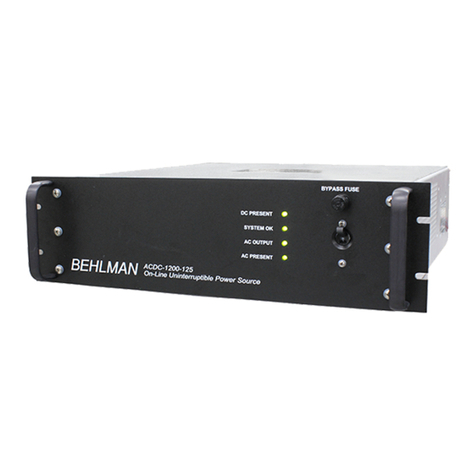
Orbit
Orbit AC/DC-1200 Series User's guide and technical reference manual

Kostal
Kostal PIKO 6.0 BA Short manual

SolarEdge
SolarEdge SE3000H-US installation guide
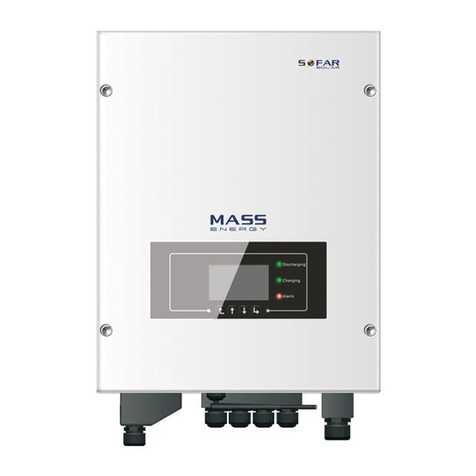
Sofar
Sofar ME3000SP user manual
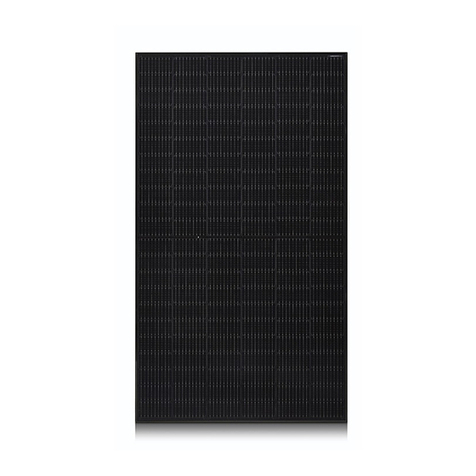
LG
LG LG N3K-V6 Series installation manual
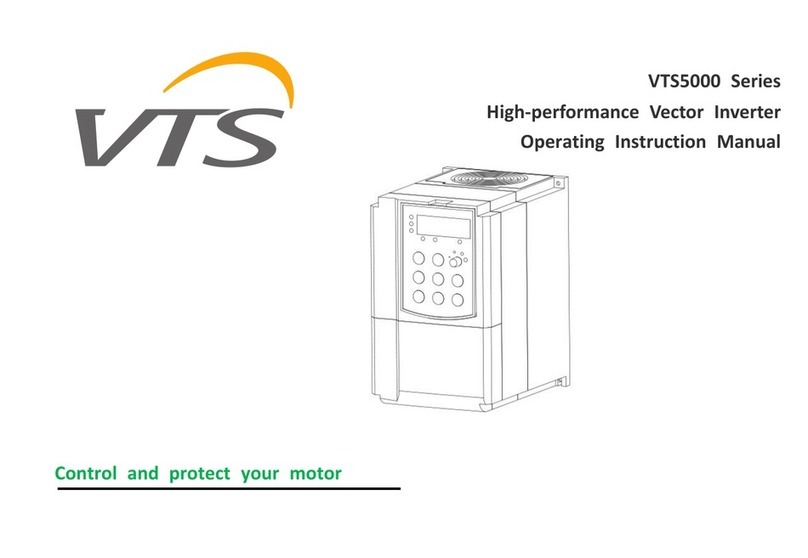
VTS Medical Systems
VTS Medical Systems VTS5000 Series Operating instructions manual
